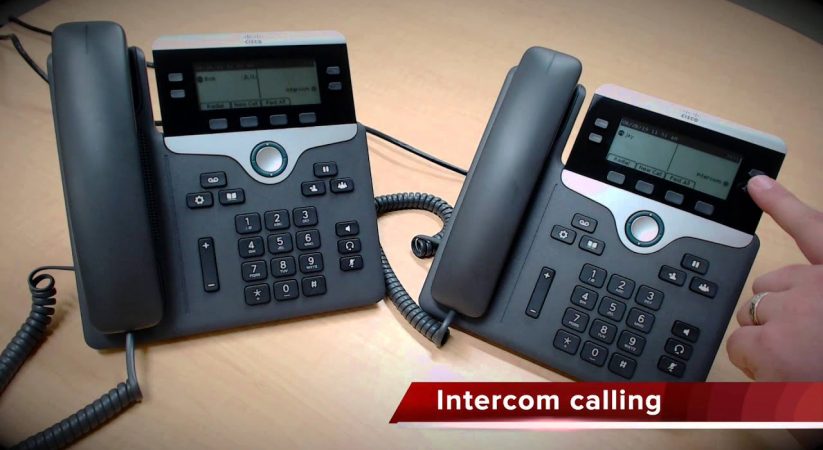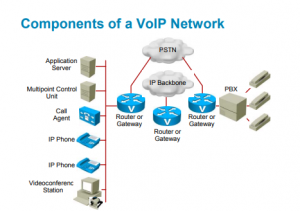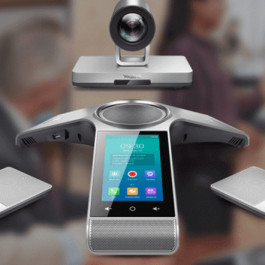VoIP stands for Voice over Internet Protocol. Since the mid-1990s, enterprises have been moving their telecommunication offerings from traditional voice networks—such as leased tie lines and private branch exchanges (PBXs)—to voice-over-IP (VoIP) technology. VoIP is the family of technologies that allow IP networks to be used for voice applications such as telephony, voice instant messaging, and teleconferencing. VoIP defines a way to carry voice calls over an IP network, including how voice streams are digitized and packetized.
Benefits and function:
Voice information is sent digitally using the same networks that you already use for the internet. In bypassing conventional phone lines, basic call costs are vastly reduced – often by as much as 40% for regular calls, and even more for international ones. You can also reduce the number of physical lines needed, as each employee can have their own virtual extension. These can be reached on any connected devices, from office desk phones to smartphones – so all of you can be kept in the loop, no matter where you are.
Auto attendants Automatic call transfer Voicemail to email transcriptions. All of these make your office communications faster and more flexible than ever before. You can keep firmly in control of these services using a simple online dashboard, accessible from anywhere with your PC or mobile device. You can quickly add users or features, and see detailed usage reports to help you save even more.
Components of a VoIP Network
The figure depicts the basic components of a packet voice network:
IP phones: IP phones provide an IP endpoint for voice communication.
Gatekeeper: The gatekeeper provides Call Admission Control (CAC), bandwidth control and management, and address translation.
Gateway: The gateway provides translation between VoIP and non-VoIP networks such as the PSTN. Gateways also provide physical access for local analog and digital voice devices such as telephones, fax machines, key sets, and PBXs.
Multipoint control unit: The multipoint control unit provides real-time connectivity for
participants in multiple locations to attend the same videoconference or meeting.
Call agent: The call agent provides call control for IP phones, CAC, bandwidth control and management, and address translation.
Application servers: Application servers provide services such as voice mail, unified messaging, and Cisco Unified Communications Manager Attendant Console.
Videoconference station: The videoconference station provides access for end-user participation in video conferencing.
3 Cisco VoIP Solutions
Here are three Cisco VoIP solutions provided from small to large business and the following products can be recommended. You can choose the suitable products for your need.
Table 1 shows the Cisco VoIP Solution for large business.
| Large | CUCM |
| ISR4451-X-V/K9+NIM-1MFT-T/E1 | UC router |
| C9300-48T-A | L3 core switch |
| C9200-48P-E or WS-C2960X-48FPS-L | L2 PoE switch |
| BE6H-M5-K9 (2500 IP PHONE) | Voice server |
| BE6K-UCL-ENH | License |
| CP-8841-K9 | IP phone |
Table 2 shows the Cisco VoIP Solution for medium business.
| Medium | CUCM |
| ISR4431-X-V/K9+NIM-1MFT-T/E1 | UC router |
| C9300-48T-A | L3 core switch |
| C9200-48P-E or WS-C2960X-48FPS-L | L2 PoE switch |
| BE6M-M5-K9 (1200 IP PHONE) | Voice server |
| BE6K-UCL-ENH BE6K-UCL-BAS | License |
| CP-8841-K9 and CP-7821-K9 | IP phone |
Table 3 shows the Cisco VoIP Solution for small business.
| Small | CME(no voice server) |
| ISR4431-X-V/K9(2500 Ip phone +NIM-1MFT-T/E1 | UC router |
| C9200-48P-E or WS-C2960X-48FPS-L | POE switch |
| CME-SRST | License |
| CP-7841-K9 and CP-7821-K9 | IP phone |
If you’re interested in Cisco IP Phone, welcome to contact us (cisco@router-switch.com) or order now: Cisco IP Phone.
Related Topics:
Buyer Guide: 5 Tips When Choosing IP Phones





